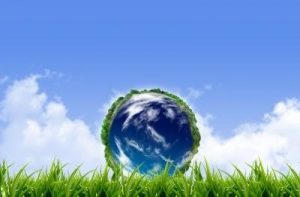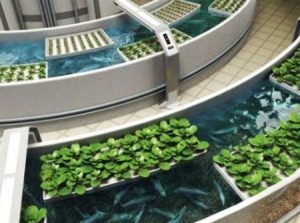Progressing From Green Economy to Blue Economy
 Green economy is defined as an economy which sustains development by reducing environmental risks and ecological paucities. It grows without degrading environment. The 2011 UNEP (United Nations Environment Programme) says that to be Green Economy, an economy must not only be efficient, but also fair. Fairness implies recognizing global and country level fairness dimensions, particularly in assuring a just transition to an economy that is low on carbon emission, resource efficient, and socially inclusive. In green economy, overall economic growth and employment is driven by public and private investments that aim at reducing carbon emissions and pollution, enhance energy and resource efficiency, and prevent the loss of biodiversity and ecosystem services. These investments need to be catalyzed and supported by targeted public expenditure, policy reforms and regulation changes. This development path should maintain, enhance and, wherever necessary, rebuild natural capital as a critical economic asset and source of public benefits. This is especially for poor people whose livelihoods and security depend strongly on nature. Germany, Brazil, Singapore, South Africa, France and Ukraine are among those countries that follow the Green Economy norms strictly.
Green economy is defined as an economy which sustains development by reducing environmental risks and ecological paucities. It grows without degrading environment. The 2011 UNEP (United Nations Environment Programme) says that to be Green Economy, an economy must not only be efficient, but also fair. Fairness implies recognizing global and country level fairness dimensions, particularly in assuring a just transition to an economy that is low on carbon emission, resource efficient, and socially inclusive. In green economy, overall economic growth and employment is driven by public and private investments that aim at reducing carbon emissions and pollution, enhance energy and resource efficiency, and prevent the loss of biodiversity and ecosystem services. These investments need to be catalyzed and supported by targeted public expenditure, policy reforms and regulation changes. This development path should maintain, enhance and, wherever necessary, rebuild natural capital as a critical economic asset and source of public benefits. This is especially for poor people whose livelihoods and security depend strongly on nature. Germany, Brazil, Singapore, South Africa, France and Ukraine are among those countries that follow the Green Economy norms strictly.
“Rio+20” is the short name for the United Nations Conference on Sustainable Development which took place in Rio de Janeiro, Brazil in June 2012, twenty years after the landmark 1992 Earth Summit in Rio. On the way to Rio+20, the Pacific Small Island Developing States (Pacific SIDS) started promoting “Blue Economy” which focuses on the marine environment. For the Pacific SIDS, “green economy” is a “blue economy” that prominently features oceans, which account for almost 71 percent of the earth’s surface. Some concerns of the Pacific SIDS are increasing their share of benefits from the use of their marine living resources and building the flexibility of marine ecosystems to the impact of climate change and ocean acidification.
 The Pacific is a diverse region made up of countries and territories with varying land sizes, populations, natural resources, economies and cultures. The main economic sectors in the region are tourism, fisheries, forestry and agriculture. Income from ocean plays an increasingly important role in the economies of Pacific SIDS, contributing towards economic growth and sustaining livelihoods, including meeting education and basic needs.
The Pacific is a diverse region made up of countries and territories with varying land sizes, populations, natural resources, economies and cultures. The main economic sectors in the region are tourism, fisheries, forestry and agriculture. Income from ocean plays an increasingly important role in the economies of Pacific SIDS, contributing towards economic growth and sustaining livelihoods, including meeting education and basic needs.
Geographic isolation and the small land area and population sizes of SIDS result in unique challenges for sustainable development. Pacific SIDS suffers from diseconomies of scale in production and exchange of goods and services: mainly because of remoteness from export markets and high vulnerability to natural disasters and climate change. Despite these challenges, the environment, culture and uniqueness produced by isolation has created a strong tourism industry with prospects for continued growth for SIDS. Isolation has also produced flexible communities with strong traditions, cultures and coping capacity.
The sustainable development agenda is a broad one, aiming to ensure inclusive economic growth for current and future generations. Economic, social and environmental dimensions comprise the pillars of a holistic and integrated approach. The single most important area where international and regional cooperation has become most urgent is climate change. Reducing the risks associated with the impacts of climate change including extreme weather and climate variability and accelerated sea level rise is a fundamental developmental challenge faced by Pacific SIDS. This must be urgently addressed in order to contribute to improving livelihoods, economic wellbeing and health, as well as maintaining biodiversity, culture and security.
Like “green economy,” which is not limited to the green ecosystem, the “blue economy” is not limited to the marine ecosystem. It is the economy that responds to the basic needs of all with what we have. As such, it stands for a new way of designing business: using the resources available in flowing systems, where the waste of one product becomes the input to create a new cash flow. Dr. Catia Bastioli, Chief Executive Officer at Novamont S.p.A which produces bioplastics in Italy, and European Inventor of the Year 2007, sums up Blue Economy: “The blue economy fosters our transition from a product-based economy to a system-based economy.”
 Gunter Pauli is a Belgian entrepreneur who started a project to find the best nature-inspired technologies that could affect the economies of the world. The result is his Report which states “Blue Economy: 100 Innovations – 10 years – 100 million jobs.” His project started the transformation of the “green economy” to “blue economy,” which is now attracting the interest of creative entrepreneurs in various countries.
Gunter Pauli is a Belgian entrepreneur who started a project to find the best nature-inspired technologies that could affect the economies of the world. The result is his Report which states “Blue Economy: 100 Innovations – 10 years – 100 million jobs.” His project started the transformation of the “green economy” to “blue economy,” which is now attracting the interest of creative entrepreneurs in various countries.
Some of the basic principles of “blue economy” are: substitute something with nothing; challenge a resource regarding its necessity for production; natural systems pour nutrients, matter and energy; waste does not exist; any by-product is the source for a new product; and sustainable business evolves with reverence, not only for local resources, but also for culture and tradition.
For flourishing the Blue Economy a beginning needs to be made from educating and motivating our youth to go into the study of the marine environment. Most of them have a limited view of opportunities in marine business which is far beyond only fishing. Youngsters think that with traditional fishing most fishermen remain poor; therefore this field does not interest them. Hence most high school students prefer courses in criminology, medicine, nursing, and engineering computer technology. Today, developing marine technology is need of the hour for protecting our oceans. Many young people need to take up careers in marine sciences and technology to begin with.
Developing a blue economy in our coastal and aquatic areas, as well as in our entire country, requires public and private sector partnership. The World Wide Fund for nature (WWF) has started project ‘The coral triangle’ for the global centre for marine biodiversity. It’s a 6 million square kilometers area spanning Indonesia, Malaysia, Philippines, Papua New Guinea, Timor Leste and the Solomon Islands. Within this area of the sea, world’s 76% coral species which include 6 of the world’s 7 marine turtle species and 2,228 reef fish species live. WWF is doing its best to protect this marine wealth. It is engaging entrepreneurs and innovators to help display the blue economy approach through the “adoption of new technology and finance schemes and facilitating Public-Private Partnerships” in the Coral Triangle.
 One example of a blue economy initiative focused on the blue ecosystem is aquaponics which is the combination of fish farming and vegetable farming. Gunter Pauli’s case study reports that aquaponics represents the highest growth in the aqua culture business, which is now the world’s fastest growing farming sector with an average worldwide growth rate of 6 to 8 percent and a worldwide value of $86 billion in 2009. Aquaponics produces cultured fish in a controlled environment. Hence, it does not deplete natural aquatic resources but only taps them for the initial stock. As per Pauli’s project report, the leading producers of cultured fish are produced 70 percent by China, India, Vietnam, Thailand, Indonesia and Bangladesh. Australia leads in providing technologies for backyard aqua or hydroponics. Another blue economy initiative in Pauli’s project is the design of ecological sound fishing boat that does not use fossil fuel. Actually, every step of the whole value chain of fishing which starts from the fishing vessel to the processing and delivering of products offers opportunities for blue economy initiatives.
One example of a blue economy initiative focused on the blue ecosystem is aquaponics which is the combination of fish farming and vegetable farming. Gunter Pauli’s case study reports that aquaponics represents the highest growth in the aqua culture business, which is now the world’s fastest growing farming sector with an average worldwide growth rate of 6 to 8 percent and a worldwide value of $86 billion in 2009. Aquaponics produces cultured fish in a controlled environment. Hence, it does not deplete natural aquatic resources but only taps them for the initial stock. As per Pauli’s project report, the leading producers of cultured fish are produced 70 percent by China, India, Vietnam, Thailand, Indonesia and Bangladesh. Australia leads in providing technologies for backyard aqua or hydroponics. Another blue economy initiative in Pauli’s project is the design of ecological sound fishing boat that does not use fossil fuel. Actually, every step of the whole value chain of fishing which starts from the fishing vessel to the processing and delivering of products offers opportunities for blue economy initiatives.
In his recent trip to Bangladesh on 6th June 2015, India’s Prime Minister Mr. Narendra Modi expressed his happiness that India and Bagladesh are working together in the area of cosmography at academic levels. In his speech Mr. Modi spoke about Blue Economy and its relevance for developing nations such as India and Bangladesh. He said that according to the UN, the ocean is the heart of our planet. Like our heart pumps blood to every part of our body, the ocean connects people across the Earth, no matter where we live. The ocean regulates the climate, feeds millions of people every year, produces oxygen and is the home to an incredible assortment of wildlife, provides us with important medicines, and so much more. In order to ensure the health and safety of our communities and future generations, it’s imperative that we take the responsibility to care for the ocean as it cares for us. Indeed the world is moving from Green Economy to Blue Economy.













































